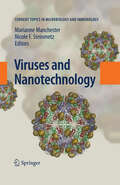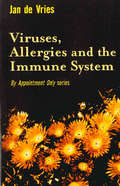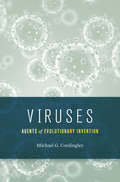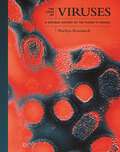- Table View
- List View
Viruses, Genes, and Cancer (Current Topics in Microbiology and Immunology #407)
by Eric Hunter Klaus BisterThis volume focuses on virus-host cell interactions, cellular genes acquired or modulated by viruses, the pathological effects of these interactions, and therapeutic interventions. Several chapters specifically address the role of viruses and genes – such as oncogenes, proto-oncogenes, or tumor suppressor genes – in the etiology of human cancer. Oncogenic signaling by PI3 kinase, mTOR, Akt, or the major cancer drivers MYC and RAF, and the role of tumor suppressors like p53, are discussed in detail. The volume also explores the emerging role of noncoding RNAs such as microRNAs in tumorigenesis and cancer therapeutics, and offers new insights into the role of HIV-host interactions relevant to pathogenesis and treatment. Gathering contributions written by leading scientists in their respective fields, the volume offers a valuable resource for researchers and clinicians alike.
Viruses: Essential Agents of Life
by Günther WitzanyA renaissance of virus research is taking centre stage in biology. Empirical data from the last decade indicate the important roles of viruses, both in the evolution of all life and as symbionts of host organisms. There is increasing evidence that all cellular life is colonized by exogenous and/or endogenous viruses in a non-lytic but persistent lifestyle. Viruses and viral parts form the most numerous genetic matter on this planet.
Viruses as Therapeutics: Methods and Protocols (Methods in Molecular Biology #2225)
by Alexandra R. LucasThis detailed volume explores methods and techniques reflecting how viruses can be a beneficial force for all levels of life as well as the mammalian microbiota. Beginning with methods for the development and study of viruses, the book continues with current techniques and approaches used to develop new treatments from virus-derived vaccines to vectors and proteins, such as a range of models and methods designed to measure therapeutic efficacy of virus-derived biologics and therapeutic proteins. Written for the highly successful Methods in Molecular Biology series, chapters include introductions to their respective topics, lists of the necessary materials and reagents, step-by-step, readily reproducible laboratory protocols, and tips on troubleshooting and avoiding known pitfalls. Authoritative and practical, Viruses as Therapeutics: Methods and Protocols is an ideal guide for researchers working to further understand how viruses can benefit lifeforms and even prevent damage from other viruses.
Viruses and the Lung: Infections and Non-Infectious Viral-Linked Lung Disorders
by Armando E. Fraire Bruce A. Woda Raymond M. Welsh Richard L. KradinViruses that primarily target the lung are very significant causes of death and in the past decade have been responsible for major outbreaks of severe adult respiratory distress syndrome and H1N1 influenza. This book is distinctive in that the entire spectrum of viral disease of the lung is conveniently compiled within a single volume. The epidemiologic, ultrastructural, immunologic, and clinicopathologic features of well-known viral pathogens and newer emergent infectious agents are discussed in detail. After sections on lung defenses and the taxonomic classification of pneumotropic viruses, the various acute viral infections are considered in a standard format in the main body of the book. Subsequent sections are devoted to the human immunodeficiency virus, viral disease in the neonate and infant, viral infections in the setting of transplantation, and viral-linked tumoral and nontumoral lung conditions. The text is supplemented by numerous color images.
Viruses and the Environment
by J.I. CooperDuring the decade since the publication of the first edition of this important book, there has been a rapid advancement in the techniques of genetic engineering and molecular biology. In this edition Joseph Cooper takes those advances into account and includes such topics as gene therapy, immunosuppression and new viruses of human/veterinary significance. Much new information about virus transmission is also included and the most modern systems of virus taxonomy are used to emphasise the features shared between viruses in plants, animals and bacteria. This is the only book of its type which covers viruses in all forms of life.
Viruses and Society
by Patricia G. MelloyViruses and Society is geared towards professionals and students in college-level introductory biology courses devoted to understanding viruses, vaccines, and their global impact. The beginning of the book introduces cells, DNA, and viruses themselves. There follows a review of how the immune system works and how scientists and physicians harness the immune system to protect people through vaccines. Specific chapters will focus on the 1918 influenza pandemic, the fight to eradicate polio, the HIV/AIDS pandemic, and our current COVID-19 crisis. Additionally, the book reviews the uses of viruses in genetic engineering and in gene therapy as well. The book will conclude by describing public health initiatives to keep emerging viruses in check and the role of scientific communication in how viruses are perceived and have an impact on our society. Key Features 1) The text employs approachable and simplified language 2) Provides all the essential elements for understanding virus biology 3) Includes details on how viruses affect individuals 4) Describes the ways public health decisions are made in light of how viral pathogens spread 5) Highlights up to date scientific findings on the features of emerging viruses that will always be with us
Viruses and Society
by Patricia G. MelloyViruses and Society is geared towards professionals and students in college-level introductory biology courses devoted to understanding viruses, vaccines, and their global impact. The beginning of the book introduces cells, DNA, and viruses themselves. There follows a review of how the immune system works and how scientists and physicians harness the immune system to protect people through vaccines. Specific chapters will focus on the 1918 influenza pandemic, the fight to eradicate polio, the HIV/AIDS pandemic, and our current COVID-19 crisis. Additionally, the book reviews the uses of viruses in genetic engineering and in gene therapy as well. The book will conclude by describing public health initiatives to keep emerging viruses in check and the role of scientific communication in how viruses are perceived and have an impact on our society. Key Features 1) The text employs approachable and simplified language 2) Provides all the essential elements for understanding virus biology 3) Includes details on how viruses affect individuals 4) Describes the ways public health decisions are made in light of how viral pathogens spread 5) Highlights up to date scientific findings on the features of emerging viruses that will always be with us
Viruses and Nanotechnology (Current Topics in Microbiology and Immunology #327)
by Marianne Manchester Nicole F. SteinmetzNanotechnology is a collective term describing a broad range of relatively novel topics. Scale is the main unifying theme, with nanotechnology being concerned with matter on the nanometer scale. A quintessential tenet of nanotechnology is the precise self-assembly of nanometer-sized components into ordered devices. Nanotechnology seeks to mimic what nature has achieved, with precision at the nanometer level down to the atomic level. Nanobiotechnology, a division of nanotechnology, involves the exploitation of biomaterials, devices or methodologies in the nanoscale. In recent years a set of b- molecules has been studied and utilized. Virus particles are natural nanomaterials and have recently received attention for their tremendous potential in this field. The extensive study of viruses as pathogens has yielded detailed knowledge about their biological, genetic, and physical properties. Bacterial viruses (bacte- ophages), plant and animal eukaryotic viruses, and viruses of archaea have all been characterized in this manner. The knowledge of their replicative cycles allows manipulation and tailoring of particles, relying on the principles of self-assembly in infected hosts to build the base materials. The atomic resolution of the virion structure reveals ways in which to tailor particles for higher-order functions and assemblies.
Viruses and Man: A History Of Interactions
by Milton W. TaylorMilton Taylor, Indiana University, offers an easy-to-read and fascinating text describing the impact of viruses on human society. The book starts with an analysis of the profound effect that viral epidemics had on world history resulting in demographic upheavals by destroying total populations. It also provides a brief history of virology and immunology. Furthermore, the use of viruses for the treatment of cancer (viral oncolysis or virotherapy) and bacterial diseases (phage therapy) and as vectors in gene therapy is discussed in detail. Several chapters focus on viral diseases such as smallpox, influenza, polio, hepatitis and their control, as well as on HIV and AIDS and on some emerging viruses with an interesting story attached to their discovery or vaccine development. The book closes with a chapter on biological weapons. It will serve as an invaluable source of information for beginners in the field of virology as well as for experienced virologists, other academics, students, and readers without prior knowledge of virology or molecular biology.
Viruses and Human Cancer: From Basic Science to Clinical Prevention (Recent Results in Cancer Research #193)
by Mei Hwei Chang Kuan-Teh JeangResearch on oncogenic viruses and related human cancers has advanced rapidly in the past decade. Most articles, however, focus on a specific oncogenic virus and cancer. There is consequently a need for a comprehensive, up-to-date monograph that offers broad and integrated knowledge. Viruses and Human Cancer – From Basic Science to Clinical Prevention is designed to meet this need by providing an advanced overview on the basic and clinical aspects of oncogenic viruses and the human cancers that they cause. Virology, virus-induced inflammation and tissue injuries, oncogenic mechanisms, epidemiology, and current and emerging preventive and therapeutic strategies are all discussed in detail. In addition, the book covers the individual aspects of seven oncogenic viruses, i.e., hepatitis B virus, hepatitis C virus, human papilloma virus, Epstein-Barr virus, human T-cell lymphotropic virus, Kaposi sarcoma-associated herpes virus, and Merkel cell polyomavirus, and the related human cancers.
Viruses and Human Cancer
by S. David HudnallViruses and Human Cancer provides a comprehensive review of the seven currently known human tumor viruses and their associated cancers with an emphasis on epidemiology, clinicopathologic features, and pathogenesis. Chapters are written by internationally recognized experts and all are generously illustrated with tables, diagrams and photographic images.Viruses and Human Cancer is designed to serve as a concise review of the field of human tumor virology for pathologists, oncologists and infectious disease specialists. It will also be of great value to practicing physicians, residents and clinical fellows in these specialties.
Viruses and Human Cancer: From Basic Science to Clinical Prevention (Recent Results in Cancer Research #217)
by T. C. Wu Mei-Hwei Chang Kuan-Teh JeangThis book, in a new, extensively updated edition, covers viral infection, virus-induced inflammation and tissue injuries, viral epidemiology, oncogenic mechanisms, and current and emerging preventive and therapeutic strategies in detail. Readers will also find information on the individual aspects of a number of oncogenic viruses, including hepatitis B, hepatitis C, human papillomavirus, Epstein–Barr virus, human T-cell lymphotropic virus, Kaposi sarcoma-associated herpes, and Merkel cell polyomavirus, as well as associated human cancers. The book will benefit all those who are seeking a comprehensive, up-to-date overview of the basic and clinical aspects of oncogenic viruses and associated human cancers. Following its original publication in 2014, the first edition of this book quickly became an influential text in the field. This second edition duly reflects the significant advances in knowledge and research that have been achieved in the years since.
Viruses and Atherosclerosis (SpringerBriefs in Immunology #4)
by Anton Kutikhin Elena Brusina Arseniy E. YuzhalinWill address an important, yet underrepresented, topic. The correlation between viruses and atherosclerosis has been a focal point of the authors’ work, for a number of years. This volume will explore the relationship between different viral strains and atherosclerosis. It will begin by describing the hypothesis and denoting the mechanisms of virus-driven atherosclerosis, then expanding on the subject by focusing on different virus strains—from Herpes, to Epstein-Barr, to the triad of Hepatitis viruses, et al—on a chapter-by-chapter basis. While there are books, albeit few, that cover particular viral strains and their relationship to cardiovascular diseases, this work will be unique in its scope by considering multiple strains of viruses, making it a repository of information on the topic; a truly comprehensive volume.
Viruses and Apoptosis (Progress in Molecular and Subcellular Biology #36)
by Covadonga AlonsoUsing different viral models, molecular pathways regulated by viral genes and their role in the pathogenesis of infection are analyzed. The book also offers an update of known signaling pathways in apoptosis and their role in normal and infected cells. Special emphasis is given to molecular pathways underlying viral transformation and oncogenesis and how research in this area is opening opportunities in cancer therapy.
Viruses, Allergies and the Immune System
by Jan De VriesWhy are problems such as viruses, allergies and post-viral syndrome increasingly prevalent today? Is it true that a simple allergy might develop into a serious degenerative disease? What part does the immune system play in these processes - and how can it be affected by lifestyle?Jan de Vries places a strong emphasis on the importance of diet, and the effects of food additives and drugs. Did you know that schizophrenia can be treated through diet? Or that the lives of hyperactive children - and their parents - can be returned to normal by eliminating even a single item from their food intake? It has even been proven that diet and allergies can have an influence on crime. Together with other well-known nutritionists from around the world, the author has studied this phenomenon in detail and includes some illuminating case histories in this book.
Viruses: Agents of Evolutionary Invention
by Michael G. CordingleyWhile viruses—the world’s most abundant biological entities—are not technically alive, they invade, replicate, and evolve within living cells. Michael Cordingley goes beyond our familiarity with infections to show how viruses spur evolutionary change in their hosts and shape global ecosystems, from ocean photosynthesis to drug-resistant bacteria.
Viruses: Agents of Evolutionary Invention
by Michael G. CordingleyWhile viruses—the world’s most abundant biological entities—are not technically alive, they invade, replicate, and evolve within living cells. Michael Cordingley goes beyond our familiarity with infections to show how viruses spur evolutionary change in their hosts and shape global ecosystems, from ocean photosynthesis to drug-resistant bacteria.
Viruses: Profile Of A Killer Virus (Very Short Introductions)
by Dorothy H. CrawfordViruses are big news. From pandemics such as HIV, to swine flu, and SARS, we are constantly being bombarded with information about new lethal infections. In this Very Short Introduction Dorothy Crawford demonstrates how clever these entities really are. From their discovery and the unravelling of their intricate structures, Crawford demonstrates how these tiny parasites are by far the most abundant life forms on the planet. With up to two billion of them in each litre of sea water, viruses play a vital role in controlling the marine environment, and are essential to the ocean's delicate ecosystem. In this fully updated edition, Crawford recounts stories of renowned killer viruses such as the recent Ebola and Zika epidemics, as well as Middle East Respiratory Syndrome, and considers the importance of air travel in facilitating the international spread of viruses in the twenty first century. Discussing the impact of global warming, which is increasing the range of vector-transmitted viruses such as dengue, yellow fever, and West Nile virus, she also considers the effect this will have on native populations in subtropical and temperate climates of the Americas, Australasia, and Europe. By examining our lifestyle in the 21st century, Crawford looks to the future to ask whether we can ever live in harmony with viruses, and considers the ways in which we may need to adapt to prevent emerging viruses with devastating consequences. ABOUT THE SERIES: The Very Short Introductions series from Oxford University Press contains hundreds of titles in almost every subject area. These pocket-sized books are the perfect way to get ahead in a new subject quickly. Our expert authors combine facts, analysis, perspective, new ideas, and enthusiasm to make interesting and challenging topics highly readable.
The Viruses: Catalogue, Characterization, and Classification (The Viruses)
by Heinz Fraenkel-ConratDuring the past two decades, virus taxonomy has advanced to the point where most viruses can be classified as belonging to families, genera, or groups of related viruses. Virus classification is primarily based on chem ical and physical similarities, such as the size and shape of the virion, the nature of the genomic nucleic acid, the number and function of com ponent proteins, the presence of lipids and of additional structural fea tures, such as envelopes, and serological interrelationships. The families, genera, or groups of viruses that have been defined on the basis of such criteria by the International Committee on Taxonomy of Viruses (ICTV) will be described in some detail in this catalogue and illustrated by elec tron micrographs. In my present attempt to list most if not all well es tablished and studied viruses in alphabetical order, I have largely confined myself to identifying them only in such taxonomic terms, generally without quoting specific data reported for individual viruses. If the latter data do not at times agree closely with those given for the taxon or group, it is difficult to decide to what extent this is attributable to misclassi fication due to insufficient data and errors in the analytical procedures and descriptions, or to what extent this is an expression of Nature's free dom of choice and abhorrence of restrictive classifications.
Viruses: Biology, Applications, and Control
by David HarperViruses: Biology, Application, and Control is a concise textbook for advanced undergraduate and graduate students covering the essential aspects of virology included in biomedical science courses. It is an updated and expanded version of David Harper‘s Molecular Virology, Second Edition. Focusing on key mechanisms and developments, Viruses presents
Viruses: A Natural History (The Lives of the Natural World #5)
by Dr. Marilyn J. RoossinckA comprehensive and richly illustrated introduction to the world of virusesAs parasites that are often hundreds of times smaller than bacteria, viruses exist in and on everything, everywhere. Rapidly evolving, they are highly opportunistic and relentlessly efficient. While some viruses are obviously agents of disease, as the COVID-19 pandemic has reminded the world only too well, others can be beneficial, helping to protect their hosts from other microbes, or allowing hosts to function in otherwise impossible ways. In Viruses, virus expert and author Marilyn Roossinck presents a comprehensive and richly illustrated introduction to viruses that reveals their true nature.Using lively text, clear graphics, and beautiful imagery, Viruses examines all the aspects of viruses that are essential for understanding them—their diversity, behaviors, life cycles, and much more. Written in a nontechnical and easy-to-follow style, the book covers what viruses are and where they come from; how they transmit and evolve; the battle between viruses and hosts, including immunity and vaccination; viruses that are good for us; the critical role viruses play in the balance of earth’s ecosystems; what makes a virus—including COVID-19 and influenza—become pandemic in plants or animals; and the cutting-edge research that is discovering thousands of new viruses. Each chapter concludes with stunningly illustrated profiles that highlight key viruses.In a world where understanding viruses is more important than ever, Viruses offers a rich and inviting introduction to organisms that, for all the harm they can do, are also essential for the health of animals, plants, and the world we share.
Virus Variability, Epidemiology and Control (Applied Virology Research #2)
by Edouard Kurstak R. G. Marusyk F. A. Murphy M. H. V. Van RegenmortelVirus Variability and Impact on Epidemiology and Control of Diseases E. Kurstak and A. Hossain I. INTRODUCTION An important number of virus infections and their epidemic developments demonstrate that ineffec tiveness of prevention measures is often due to the mutation rate and variability of viruses (Kurstak et al., 1984, 1987). The new human immunodeficiency retroviruses and old influenza viruses are only one among several examples of virus variation that prevent, or make very difficult. the production of reliable vaccines. It could be stated that the most important factor limiting the effectiveness of vaccines against virus infections is apparently virus variation. Not much is, how ever, known about the factors influencing and responsible for the dramatically diverse patterns of virus variability. II. MUTATION RATE AND VARIABILITY OF HUMAN AND ANIMAL VIRUSES Mutation is undoubtedly the primary source of variation, and several reports in the literature suggest that extreme variability of some viruses may be a consequence of an unusually high mutation rate (Holland et al., 1982; Domingo et al., 1985; Smith and Inglis, 1987). The mutation rate of a virus is defined as the probability that during a single replication of the virus genome a particular nucleotide position is altered through substitution, deletion, insertion. or recombination. Different techniques have been utilized to measure virus mutation rates, and these have been noted in the extent of application to different viruses.
Virus- und Rickettsieninfektionen des Menschen
by R. Haas O. VivellUnter Mitarbeit zahlreicher Fachwissenschaftler
Virus und Molekularbiologie: Eine elementare Einführung (Heidelberger Taschenbücher #3)
by W. WeidelVirus Taxonomy: Classification and Nomenclature of Viruses (Archives of Virology. Supplementa #10)
by Claude M. Fauquet David H. L. Bishop Said A. Ghabrial Audrey W. Jarvis Giovanni P. Martelli Mike A. Mayo Max D. Summers Frederik A. MurphyVirology Division. International Union of Microbiological Societies.























